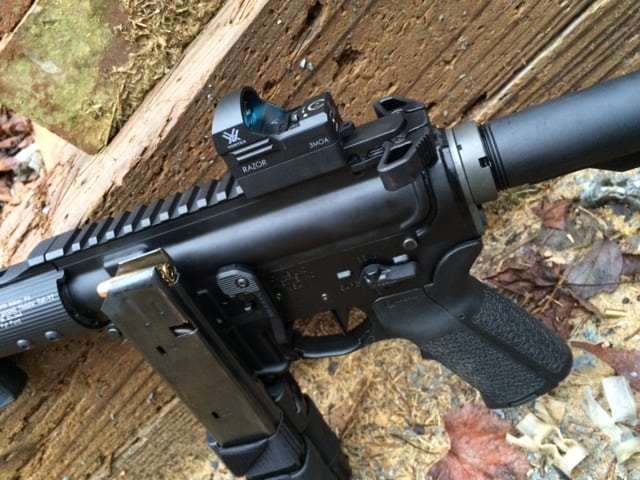Finally got yourself a red dot scope eh? Only to mount it and fire off a couple shots down range to produce a hit spread that looks like you were firing birdshot from distance? Hopefully you don’t get that far before you realize you need to “sight in” the scope first.
If you’re looking to have a spread so tight it leaves nothing but a hole in the target– welcome to the club. Just follow these instructions and watch that spread begin to close with every step you take. As I walk you threw how to sight in a red dot scope.
Everything you need to sight in your scope
Depending on the type of firearm and your comfort with it there’s a couple ways to go about this. However for beginners using a sight-in target for times sake is your best bet. Regardless of method after you’ve got the sight and the weapon you’re still going to need some things.
Paper Targets – There are many different types of paper targets, but you’re going to need to get your hands on a few. If you have a printer then the link provided can be used to print out some quality sight in paper. I recommend using the 1 inch grid paper because most beginner scopes aren’t able to adjust at smaller increments.
Flat Head Screwdriver – In order to make adjustments for the scope you’re going to want to use a screw driver. The adjustment screws are generally flat heads.
Marker – Any marker will work. Just make sure its easily visible amidst the gridlines.
Ear Protection – Don’t forget to bring some ear protection. A lot of ranged will offer some foamies like the kind I’ve linked here, but just in case its good to have some. Having your own will also stop you from having to shell out extra money if the range doesn’t provide.
Related: Best Red Dot Scopes for AR 15
How to sight in a red dot scope
This is a youtube video as reference in case anything doesn’t make sense. The video covers the idea behind sighting in very well. If at any time you need to; please feel free to check it out.
Step 1) Safety First
In the military the first thing new recruits learn about firearms is safety. So much so that the phrase “Treat. Never. Keep. Keep.” is engrained into memory and I advise you to do the same. Treat every weapon as if it were loaded. Never aim at anything you don’t intend to shoot. Keep your finger straight and along the receiver until ready to fire. Keep the weapon on safe until ready to fire.
Follow these simple rules and you should have no easily preventable mishaps. Couple that with good use of ear protection and shooting will quickly become a relaxing experience.
Step 2) Hang Target & Set Range
Whether you are at a range that has automatic target lines for ranging or your hoofing it down range to hang a target. It’s important to know what range you want to shoot at. For most rifles such as an AR15 you should look to set your target at 50 yards.
This will provide a zero point at the 50 yards and 200 yards due to projectile drop paths. However if your using a smaller handgun you will want to set the target at 25 yards to sight in your red dot scope.
Step 3) Fire
After checking for a clear firing line it’s time to let some rounds down range. You want to aim for the center of the target and fire off 2-3 rounds.
If your grouping (impact spread) is nice, but nowhere near where you aimed then its time for the next step. However, if the rounds went all over the place you should take a few more practice shots before continuing.
Related: How to sight in a scope at 25 yards
Step 4) Make Adjustments
Now that your spread is nice it’s time to see what adjustments need to be made. After recalling your use your marker to count the amount of squares your shot is above or below the horizontal centerline and write that number on your target.
Then remove the elevation adjustment cap and turn the adjustment screw in the desired direction. If you are using the 1inch paper at 50 yards this should be 2 times the number you counted, or if using 1 inch paper at 25 yards it’s going to be 2.5 times the number you counted and round down. So if you shoot 5 below the centerline you would turn your elevation adjustment in the “Up” direction labeled on your adjustment screw until it clicks 10 times.
Then you’re going to want to repeat this process for your distance from the vertical centerline on the target using the windage adjustment screw. In case it isn’t labeled on the screw you will be turning the screw the opposite way you want the round to go.
Step 5) Fire & Finish
After making your adjustments and replacing both windage and elevation caps it is time to start once again. If you were lucky enough to nail it the first time then congratulations, but for most people it takes a few tries, so don’t be afraid to adjust it more than once. Just repeat these steps until you are as close to the center as you can get.
Commonly Asked Questions
How do I mount a red dot scope? – We have a guide that will show you step by step how to mount your scope to your rifle.
What does “1 MOA = 1 click” mean? – An MOA (Minute of Angle) is the unit of measurement to calculate the amount of adjustment needed to move the impact point a certain distance. In this guide we use 1 MOA @ 50 yards is equal to a ½ inch of our grid paper.
Related: How to use a mil dot reticle
Conclusion
All in all it takes time to get a scope sighted in perfectly so don’t rush things. Slow is steady and steady is fast. This way is the simplest method and should give you the means to blow straight through the center of whatever target it is your shooting at. I hope you enjoyed this tutorial and learned how to sight in a red dot scope.
If you enjoyed this article you’ll probably like these:



